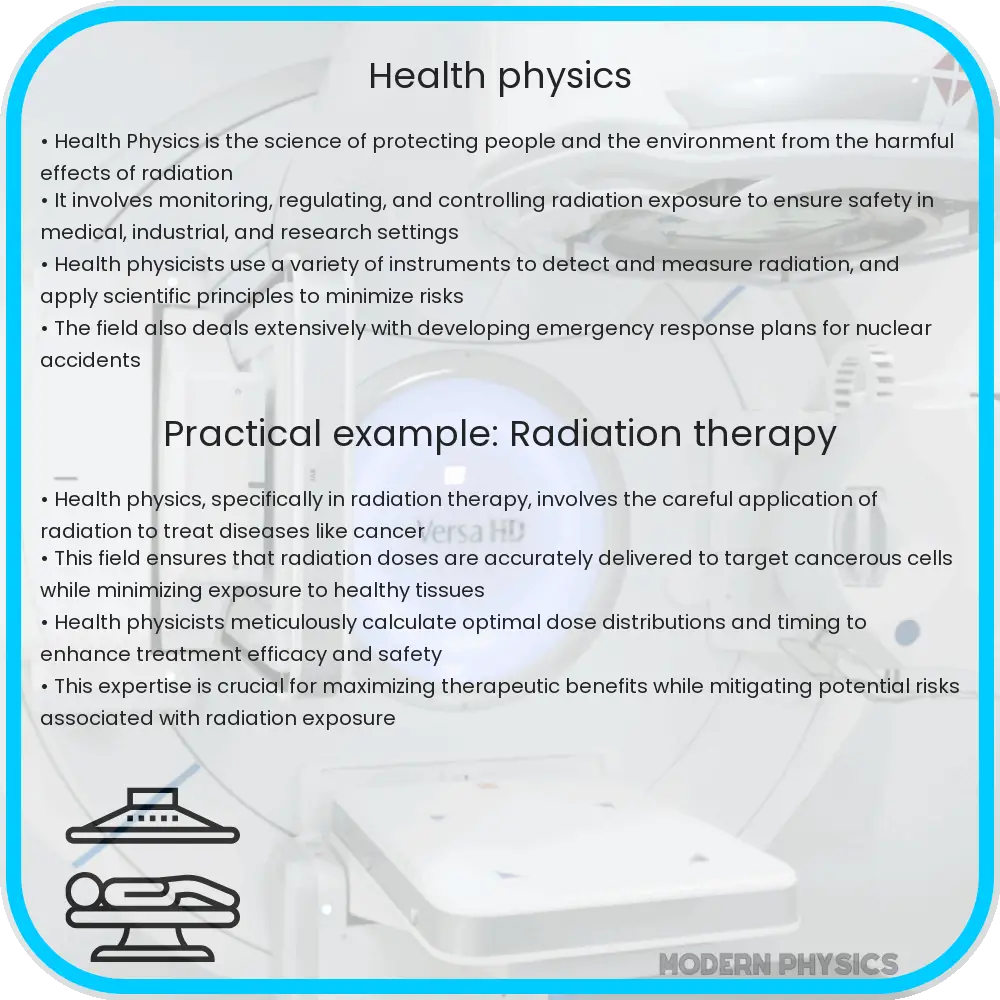Learn about Health Physics, the science dedicated to radiation protection and safety, ensuring safe use while minimizing exposure risks in various sectors.

Introduction to Health Physics: Understanding Radiation Safety
Health Physics, also termed as the science of radiation protection, is a vital field that focuses on protecting humans and their environment from the potential hazards of ionizing radiation, while permitting its safe usage. It plays a crucial role in various sectors including medical, industrial, and nuclear power generation.
The Nature of Ionizing Radiation
Ionizing radiation refers to energy in the form of rays or particles that are capable of detaching electrons from atoms, thus ionizing them. This type of radiation can be emitted from radioactive materials, X-ray tubes, and nuclear reactions. Common forms include alpha and beta particles, gamma rays, and neutrons.
Radiation Safety and Protection Principles
To safeguard health and minimize risk, the principles of radiation protection are essential. Key strategies include:
- Time: Reducing the time of exposure to radiation sources helps decrease the dose absorbed.
- Distance: Increasing distance from the source reduces exposure following the inverse square law, which states that dose intensity decreases proportionally to the square of the distance from the source.
- Shielding: Using materials that absorb or block radiation (e.g., lead, concrete, water) can effectively protect against exposure.
Compliance and Regulatory Frameworks
Health Physics is regulated under a framework that ensures public and environmental safety. In the United States, the Nuclear Regulatory Commission (NRC) along with state agencies, enforces rigorous standards for radiation protection. These regulations involve monitoring of occupational exposure to radiation, disposal of radioactive waste, and emergency response to radiological incidents.
Medical Applications of Radiation
The medical field utilizes ionizing radiation for both diagnosis and treatment of diseases. Diagnostic imaging techniques like X-rays, mammograms, and CT scans rely on radiation to create detailed images of the body’s interior. Meanwhile, in cancer treatment, radiation therapy involves targeting malignant cells with focused radiation to destroy or damage them, while aiming to preserve surrounding healthy tissue.
Understanding the biological effects of radiation is key to its medical applications. The degree to which radiation affects biological tissues is influenced by the type and energy of the radiation, as well as the duration and mode of exposure. High doses can cause acute health effects, while lower doses carry a risk of long-term impacts such as cancer.
Occupational Health and Radiation
Workers in industries such as healthcare, nuclear power, and radiology are particularly at risk of exposure to ionizing radiation. Consequently, health physics programs implement stringent training and safety protocols to protect these workers. Measurements of radiation levels in workplaces and the use of personal dosimeters help ensure exposure remains below recommended thresholds.
Educational Outreach and Public Awareness
Public perception of radiation risks can often be skewed by misinformation. Educational outreach is critical in health physics to demystify radiation and its applications. Informative campaigns and resources aim to enhance public understanding, promoting informed decision-making regarding radiation technologies.
Sustainable Practices in Radiation Use
Sustainability in radiation use involves not only protecting present populations but also ensuring no long-term harm to future generations. This includes developing new technologies for safer radiation management and improving disposal methods to prevent environmental contamination.
Technological Advances in Health Physics
The field of health physics is continuously evolving with advancements in technology. Innovations like better radiation detection instruments, enhanced imaging techniques, and more effective radiation shielding materials contribute to increased safety and efficiency in uses of ionizing radiation.
Conclusion
Health Physics serves as a critical discipline ensuring the safe use of ionizing radiation in various fields, from medical treatments to nuclear energy production. By understanding the fundamentals of ionizing radiation, adopting rigorous safety practices, and complying with regulatory frameworks, we can mitigate the associated risks while harnessing the benefits of this powerful technology. Continued innovation and education are essential to advancing radiation safety and fostering public trust in radiation-based technologies. As we look to the future, the role of health physics will undoubtedly expand, further integrating safety with scientific and technological progress.
